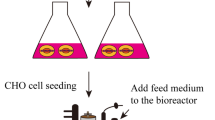Abstract
Insect cells are used for the expression of complex proteins in products such as vaccines and biopharmaceuticals. Physiology of a Drosophila melanogaster (lineage S2), transfected to stably express rabies virus glycoprotein (RVGP), was studied in batch culture and in a chemostat with serum-free medium. In batch mode, the system reached 3 × 107 cells mL−1 with specific growth rate of 1.5 d−1 with RVGP at 2.50 µg L−1. When operated continuously, three well-defined steady states were achieved at dilution rates (D) of 0.8, 0.5 and 0.2 d−1. The residual glucose and glutamine concentrations and the cell yields on glucose and glutamine decreased at lower D. High values of substrate consumption for maintenance may explain this variation in yields. The results indicated that glucose is not the limiting substrate of this process.


Similar content being viewed by others
Abbreviations
- CV:
-
Coefficient of variation
- D:
-
Dilution rate
- GLC:
-
Glucose concentration
- GLN:
-
Glutamine concentration
- mS :
-
Maintenance coefficient
- µMax :
-
Maximum specific growth rate
- NH4 :
-
Ammonium concentration
- RVGP:
-
Rabies virus glycoprotein
- S2:
-
Drosophila melanogaster cells lineage
- X:
-
Viable cell concentration
- YNH4/GLN :
-
Ammonium yield on glutamine
- YNH4/X :
-
Ammonium yield on cells
- YX/GLC :
-
Cell yield on glucose
- YX/GLN :
-
Cell yield on glutamine
- YX/S :
-
Global cell yield on substrate
- Y trueX/S :
-
True cell yield on substrate
References
Batista FRX, Moraes AM, Büntemeyer H, Noll T (2009) Influence of culture conditions on recombinant Drosophila melanogaster S2 cells producing rabies virus glycoprotein cultivated in serum-free medium. Biologicals 37:108–118
Bedard C, Tom R, Kamen A (1993) Growth nutrient consumption and end product accumulation in Sf9 and BTI-EAA insect cell cultures: insights into growth limitation and metabolism. Biotechnol Prog 9:615–624
Bovo R, Galesi ALL, Jorge SAC, Piccoli RAM et al (2008) Kinetic response of a Drosophila melanogaster cell line to different medium formulations and culture conditions. Cytotechnology 57:23–35
Chisti Y (2001) Hydrodynamic damage to animal cells critical. Crit Rev Biotechnol 21:67–110
Compton ME (2011) Elements of in vitro research. In: Trigiano RN, Gray DJ (eds) Plant tissue culture, development, and biotechnology. CRC Press, Boca Raton, pp 57–64
Galesi ALL, Aguiar MA, Astray RM, Augusto EFP et al (2008) Growth of recombinant Drosophila melanogaster Schneider 2 cells producing rabies virus glycoprotein in bioreactor employing serum-free medium. Cytotechnology 57:73–81
Hoskisson PA, Hobbs G (2005) Continuous culture––making a comeback? Microbiology 151:3153–3159
Ikonomou L, Schneider YJ, Agathos SN (2003) Insect cell culture for industrial production of recombinant proteins. Appl Microbiol Biotechnol 62:1–20
Jorge SA, Santos AS, Spina A, Pereira CA (2008) Expression of the hepatitis B virus surface antigen in Drosophila S2 cells. Cytotechnology 57:51–59
Lim HJ, Cha HJ (2006) Observation and modeling of induction effect on human transferring production from stably transfected Drosophila S2 cell culture. Enzym Microb Technol 39:208–214
Moraes AM, Jorge SAC, Astray RM, Suazo CAT et al (2012) Drosophila melanogaster S2 cells for expression of heterologous genes: from gene cloning to bioprocess development. Biotechnol Adv 30:613–628
Pamboukian MM, Jorge SAC, Santos MG, Yokomizo AY et al (2008) Insect cells respiratory activity in bioreactor. Cytotechnology 57:37–44
Pirt SJ (1965) The maintenance energy of bacteria in growing. Proc R Soc Lond B Biol Sci 163:224–231
Swiech K, Rossi N, Astray RM, Suazo CAT (2008) Enhanced production of recombinant rabies virus glycoprotein (rRVGP) by Drosophila melanogaster S2 cells through control of culture conditions. Cytotechnology 57:67–72
Ventini DC, Astray RM, Lemos MAN, Jorge SAC et al (2010) Recombinant rabies virus glycoprotein synthesis in bioreactor by transfected Drosophila melanogaster S2 cells carrying a constitutive or an inducible promoter. J Biotechnol 146:169–172
Yokomizo A, Jorge S, Astray R, Fernandes I et al (2007) Rabies virus glycoprotein expression in Drosophila S2 cells. I. Functional recombinant protein in stable co-transfected cell line. Biotechnol J 2:102–109
Acknowledgments
This work was supported by CNPq (Conselho Nacional de Desenvolvimento Científico e Tecnológico).
Author information
Authors and Affiliations
Corresponding author
Rights and permissions
About this article
Cite this article
Vieira, P.B., da Costa, B.L.V., de Fatima Pires Augusto, E. et al. Culturing Drosophila melanogaster (S2) in a chemostat. Biotechnol Lett 37, 533–538 (2015). https://doi.org/10.1007/s10529-014-1717-9
Received:
Accepted:
Published:
Issue Date:
DOI: https://doi.org/10.1007/s10529-014-1717-9




